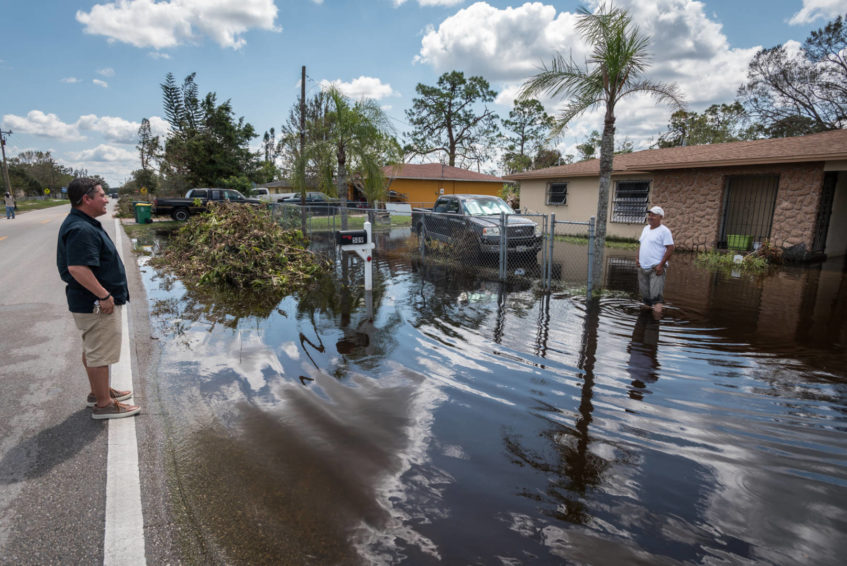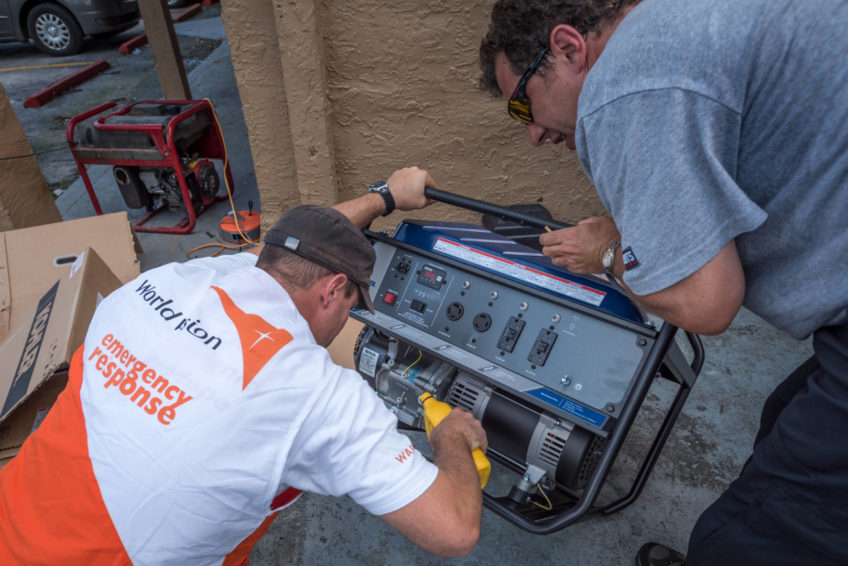Hurricane Irma struck Florida as a Category 4 storm the morning of September 10, 2017. It tore off roofs, flooded coastal cities, and left more than 6.8 million people without power. By September 11, Irma had weakened significantly to a tropical storm as it moved north toward Georgia and Alabama. Later that day, it weakened further to a tropical depression. Irma was the fifth-costliest hurricane to hit the mainland United States, causing an estimated $50 billion in damage, according to the National Hurricane Center.

Hurricane Irma: Facts, FAQs, and how to help
Explore Hurricane Irma facts and frequently asked questions, and learn how you can help disaster survivors in the U.S.
- Fast facts: Hurricane Irma
- How many people died in Hurricane Irma?
- How did Hurricane Irma develop?
- How much damage did Hurricane Irma cause?
- Where did Hurricane Irma hit?
- Timeline of Hurricane Irma’s path
- When did Hurricane Irma hit Florida?
- How much damage did Hurricane Irma cause?
- How has World Vision responded?
- How can I help disaster survivors?
Fast facts: Hurricane Irma
- Irma made landfall over the Florida Keys as a Category 4 hurricane the morning of Sept. 10, 2017.
- At its peak, Hurricane Irma was a Category 5 with wind speeds of 177 mph.
- 6 million Florida residents evacuated coastal areas.
- 129 direct and indirect deaths were caused by Hurricane Irma.
- It is the fifth-costliest hurricane to hit the mainland United States.
How many people died in Hurricane Irma?
Hurricane Irma is directly responsible for 47 deaths due to its strong winds, heavy rains, and high surf across the Caribbean Islands and the southeastern United States. The majority of the casualties were in the Caribbean Islands, where Irma’s winds were the strongest, according to the National Hurricane Center. Irma caused 10 deaths in the United States — seven in Florida, two in Georgia, and one in South Carolina. Another 82 deaths are also indirectly attributed to Hurricane Irma, 77 of which were in Florida. Hundreds more were injured before, during, or after the hurricane.
How did Hurricane Irma develop?
Hurricane Irma began on Aug. 30 , 2017, near the Cape Verde Islands. It was the ninth named storm and fourth hurricane of the 2017 storm season.
Irma developed from a tropical wave that developed off the West African coast two days earlier. It rapidly strengthened into a Category 2 storm within 24 hours. Irma’s intensity fluctuated in the days to follow, and on Sept. 4 became a Category 4 hurricane.
A day later on Sept. 5, it grew to Category 5 strength with sustained winds above 157 mph. Irma wrought catastrophe in Barbuda and parts of the U.S. and the British Virgin Islands. Puerto Rico, the Dominican Republic, and Haiti each experienced flooding and heavy damage in some areas, but the storm left much less destruction than expected.
Hurricane Irma was downgraded to a Category 4 on Sept. 8 but maintained winds around 150 mph. Irma made landfall over mainland Florida early Sept. 10 as a Category 4 hurricane. From there, it weakened significantly to a tropical storm on September 11 as it powered north toward Georgia and Alabama. At 11 p.m. later that day, it weakened further to a tropical depression, and by Sept. 13, it had dissipated over western Tennessee.
Hurricane Jose was on Irma’s tail but weakened to a Category 1 storm before stalling out at sea.
How much damage did Hurricane Irma cause?
Irma is the fifth-costliest hurricane to hit the mainland United States and caused an estimated $50 billion in damage, according to the National Hurricane Center. At one point, Hurricane Irma was the strongest hurricane the National Hurricane Center has ever recorded in the Atlantic outside of the Caribbean Sea and the Gulf of Mexico. It was moving as a Category 5 storm, which means it had sustained wind speeds greater than 157 mph. Category 5 storms cause catastrophic damage when they make landfall. Irma hit the Florida Keys as a Category 4 hurricane and then the mainland as a Category 3.
Hurricane Matthew hit the southern part of Haiti as a Category 4 storm on Oct. 4, 2016, and the country still hasn’t fully recovered from that devastating storm. Projections had Irma hitting Haiti hard, but the country was spared from severe devastation.
Where did Hurricane Irma hit?
The storm tracked northwest through the Caribbean, along Florida’s west coast, and into Georgia, Alabama, Mississippi, and South Carolina, eventually dissipating over Tennessee.
Timeline of Hurricane Irma’s path
Wednesday, Sept. 6:
- Hit Antigua and Barbuda just before 2 a.m. Half of the 100,000 residents of Antigua and Barbuda had their homes destroyed or heavily damaged.
- Hit St. Martin, Anguilla, St. Kitts, and Nevis around 8 a.m.
- Hit the British Virgin Islands, U.S. Virgin Islands, and Puerto Rico at about 2 p.m. The governor of Puerto Rico said electricity was restored to 144,000 homes in the days following.

Thursday, Sept. 7:
- Dominican Republic: The storm sustained its Category 5 strength, with maximum sustained winds of 175 mph, but the Dominican Republic avoided a direct hit as it skirted just off its northern coast around 11 a.m. local time.
- Haiti: Haiti was hit but didn’t experience nearly as much impact as expected.
- Turks and Caicos: Irma hit late Thursday, and extensive damage is being reported.
Friday, Sept. 8:
- Cuba and the Bahamas: Irma hit as a Category 5 around noon Eastern time.
Saturday and Sunday, Sept. 9 and 10:
- Hurricane Irma pummeled the Florida Keys late Saturday into Sunday as a Category 4 and hit the Florida mainland as a Category 3 storm around 1 p.m. Eastern time Sunday.

Monday, Sept. 11:
- Irma weakened significantly to a tropical storm as it powered north toward Georgia and Alabama.
- The National Hurricane Center says Florida’s coast saw storm surges between 1 and 6 feet, according to the Weather Channel.
- About 11 p.m., Irma weakened further to a tropical depression.
Tuesday, Sept. 12:
- Irma traveled northwest through Georgia and South Carolina on its way to Alabama, Mississippi, and Tennessee.
- As many as 15 million people in Florida are without power, and restoring it could take weeks.
Wednesday, Sept. 13:
When did Hurricane Irma hit Florida?
Hurricane Irma made landfall over the southern Florida mainland around 1 p.m. local time Sunday, Sept. 10 as a Category 3 storm, packing winds of more than 110 miles per hour. It roared its way north, overwhelming the entire state with heavy rains and fierce winds.
How much damage did Hurricane Irma cause?
The wind and water damage in the United States caused by Hurricane Irma totaled $50.0 billion, according to the NOAA National Centers for Environmental Information. This makes Irma the fifth-costliest hurricane to affect the United States, behind Katrina (2005), Harvey (2017), Maria (2017) and Sandy (2012).
How has World Vision responded?
In the immediate aftermath, World Vision sent semitrucks full of relief supplies to several church partners in Immokalee, Fort Myers, and the Florida Keys. We were able to reach more than 18,000 people in some of the hardest-hit areas with food, water, hygiene supplies, and other items. About 400 affected families also received $500 gift cards so they could purchase items they needed most, including materials to repair their homes.
Thanks to generous donors and corporate partners, we could keep our warehouses around the country well-stocked to quickly respond to hurricanes Irma, Harvey, and Maria simultaneously. Our team was also able to deliver generators to local partners, including churches that needed power to serve hot meals to storm survivors. While the relief phase has moved toward rebuilding, we have committed to providing regular supplies shipments to a church partner in Immokalee to ensure their community is supported through the difficult recovery.

World Vision staff in Haiti and the Dominican Republic also responded to damage in their countries, although they avoided the more severe effects felt in other parts of the Caribbean.

How can I help disaster survivors?
- Give: Help us continue the flow of emergency supplies to disasters in the U.S. like Hurricane Irma by donating to World Vision’s disaster relief fund.
- Pray: Join us in praying for World Vision staff and responders as they help families recover and rebuild. Almighty Father, we ask for Your mercy on those hit hard by Hurricane Irma. Amid their struggle to recover, give them patience, peace, and hope that their lives and livelihoods will improve.


















